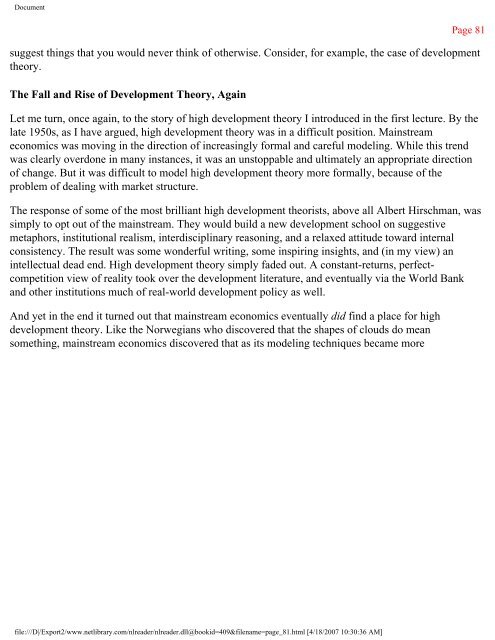Document file:///D|/Export1/www.netlibrary.com/nlreader/nlreader.dll ...
Document file:///D|/Export1/www.netlibrary.com/nlreader/nlreader.dll ...
Document file:///D|/Export1/www.netlibrary.com/nlreader/nlreader.dll ...
You also want an ePaper? Increase the reach of your titles
YUMPU automatically turns print PDFs into web optimized ePapers that Google loves.
<strong>Document</strong><br />
Page 81<br />
suggest things that you would never think of otherwise. Consider, for example, the case of development<br />
theory.<br />
The Fall and Rise of Development Theory, Again<br />
Let me turn, once again, to the story of high development theory I introduced in the first lecture. By the<br />
late 1950s, as I have argued, high development theory was in a difficult position. Mainstream<br />
economics was moving in the direction of increasingly formal and careful modeling. While this trend<br />
was clearly overdone in many instances, it was an unstoppable and ultimately an appropriate direction<br />
of change. But it was difficult to model high development theory more formally, because of the<br />
problem of dealing with market structure.<br />
The response of some of the most brilliant high development theorists, above all Albert Hirschman, was<br />
simply to opt out of the mainstream. They would build a new development school on suggestive<br />
metaphors, institutional realism, interdisciplinary reasoning, and a relaxed attitude toward internal<br />
consistency. The result was some wonderful writing, some inspiring insights, and (in my view) an<br />
intellectual dead end. High development theory simply faded out. A constant-returns, perfect<strong>com</strong>petition<br />
view of reality took over the development literature, and eventually via the World Bank<br />
and other institutions much of real-world development policy as well.<br />
And yet in the end it turned out that mainstream economics eventually did find a place for high<br />
development theory. Like the Norwegians who discovered that the shapes of clouds do mean<br />
something, mainstream economics discovered that as its modeling techniques became more<br />
<strong>file</strong>:///<strong>D|</strong>/Export2/<strong>www</strong>.<strong>netlibrary</strong>.<strong>com</strong>/<strong>nlreader</strong>/<strong>nlreader</strong>.<strong>dll</strong>@bookid=409&<strong>file</strong>name=page_81.html [4/18/2007 10:30:36 AM]
















